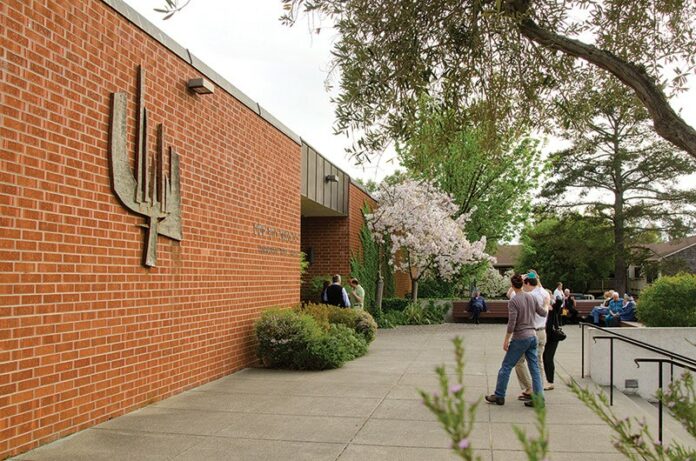Walk into Miller’s East Coast Delicatessen in San Rafael on any given day, and you might catch a Woody Allen–type moment: a Jewish couple trying to talk their toddler into trying the “very healthy, good-for-you” matzo ball soup, or three generations feasting on pastrami sandwiches, trying to please their East Coast-transplant grandpa.
This might be the one and only Jewish-style deli from Eureka to San Francisco, but the vibe leaves no room for doubt: the Jewish spirit, unbeknown to the unassuming outsider, is having a Northern California revival.
Robby Morgenstein, a Maryland native who grew up among “classic, East Coast Jews,” opened the San Rafael outpost of his S.F. establishment almost half a year ago, after moving to Novato and falling in love with the area. “I take my job very seriously: providing traditional Jewish food in Marin. The responses are very embracing. The high holy days were very busy.”
For an uninformed North Bay resident, “high holidays” may take on a completely different meaning than the original. The term refers to Rosh Hashanah and Yom Kippur, two major Jewish holidays. During those events through the month of September, and up until the end of October, marked with Sukkot, another annual holiday, the North Bay Jewish population could be found mingling, noshing and praying at more than 20 different congregations.
According to the North American Jewish Data Bank numbers as of 2011, Marin County is the home of the largest Jewish population in California, and holds ninth place in the rank of all U.S. counties. But behind the numbers and the exotic-sounding signs —”Shomrei Torah,” “Kol Shofar,” “Beth Ami”—there’s community resourcefulness and creativity that marry good old traditions with Northern California’s complex and compelling demography and, well, topography.
“We’re well aware of the region’s gravitation toward nature and its spirituality,” says Rabbi Ted Feldman from B’nai Israel Jewish Center in Petaluma. “On Shabbat, for example, we do a prayer and a hike.” The Petaluma Jewish community, with over 110 families, recently celebrated its 150th anniversary, an occasion to be marked with a special photo exhibition in February 2015.
“Many families came here right after World War II and the Holocaust, and infused the community with the values they grew up with in Eastern and Western Europe,” explains Feldman. He’s been with the congregation for 10 years and doesn’t hesitate to mix the old with the new. Meditation and hikes are deliberate attempts to strengthen the connection between Jewish life and outdoorsy fun typical to the region.
Jews are anything but black-and-white. As Judaism is largely considered an ethno-religious group, one is automatically born Jewish to a Jewish mother, even if synagogue visits were never on the agenda. In other words, you can do absolutely nothing on the religious side and still declare yourself as “Jewish.” This delicate tension between identity, ethnicity, and religion gives rise to a particular approach within congregations.
“Jewishness has increasingly become an acquired taste, not a historical obligation,” writes Charles S. Leibman in “Unraveling the Ethno-Religious Package” collected in Contemporary Jewries: Convergence and Divergence, a work dedicated to American Judaism. This observation from more than 10 years ago rings even truer now. Take, for example, Congregation Rodef Shalom, San Rafael’s influential Jewish centerpiece. It belongs to the Reform Movement, the liberal, modern stepbrother of conservative Judaism. Members and visitors of all religions can join services and holiday activities or attend a camp-style Shabbat dinner, an event signifying a shift from the work week to a day of self-reflection and rest.
“There are many shades of gray here. We’re helping people to find meaning and connection,” says Meredith Parnell, the congregation’s director of communications. Parnell notes an interesting phenomenon, completely in line with Liebman’s notion: while the Jewish population isn’t necessarily growing in numbers, “more people participate more often. We’re making it easier, working with their interests and still making it Jewish. So people feel more comfortable. Some of it is that we move away from converting to invitation and inclusiveness.”
Such interests may include food festivals, book clubs or a film festival, such as the annual Jewish Film Festival organized by the Jewish Community Center of Sonoma County and Rialto Cinemas.
“The reality is, most people aren’t religious at all, but they lead fairly Jewish lives,” says Parnell, and Rabbi Feldman notes that “in the younger generations, Judaism is viewed as another activity of life, not as the center of life.” As with the Bar Mitzva, values such as community, human relationships and self-discovery take center stage and overshadow theological convictions. The “acquired taste” of Judaism is ever-changing—even if the classic flavor of pastrami refuses to adapt.











